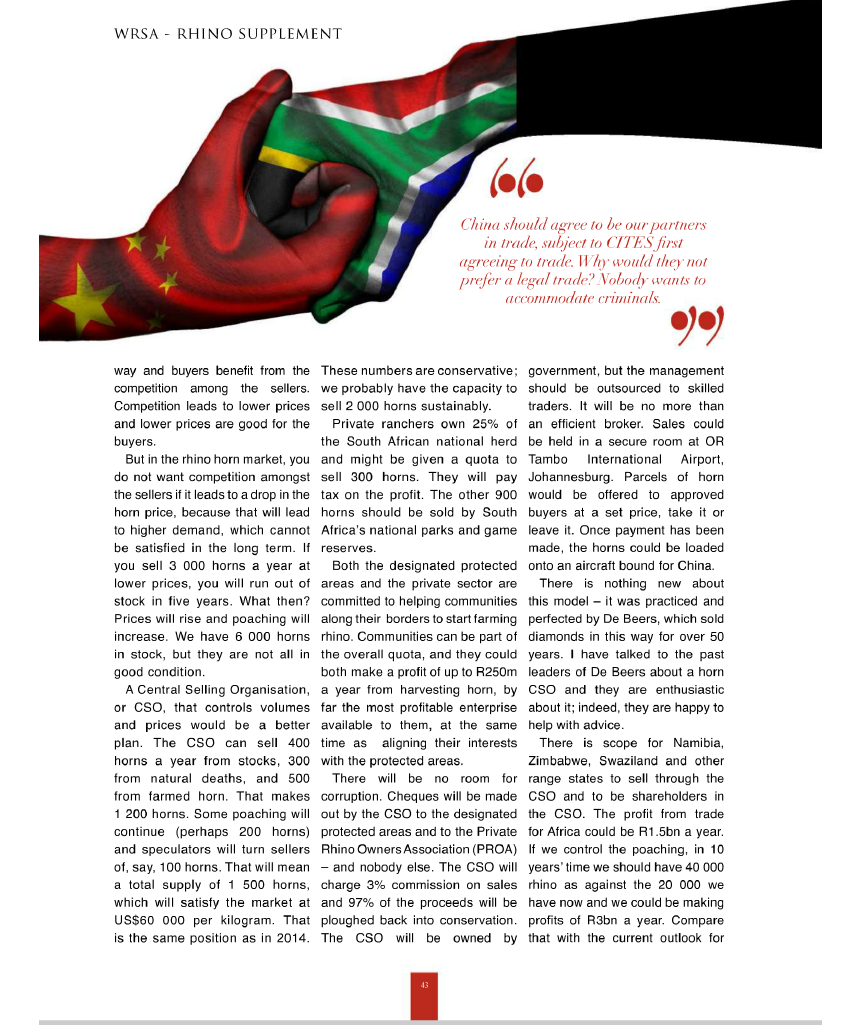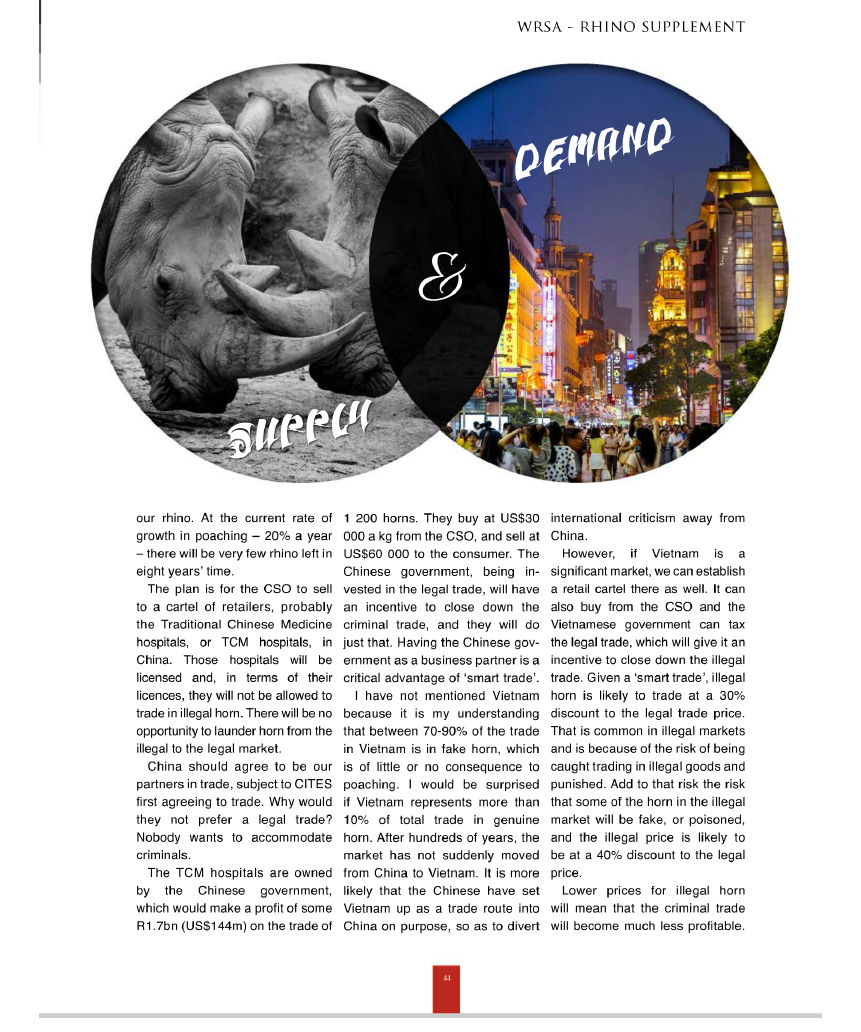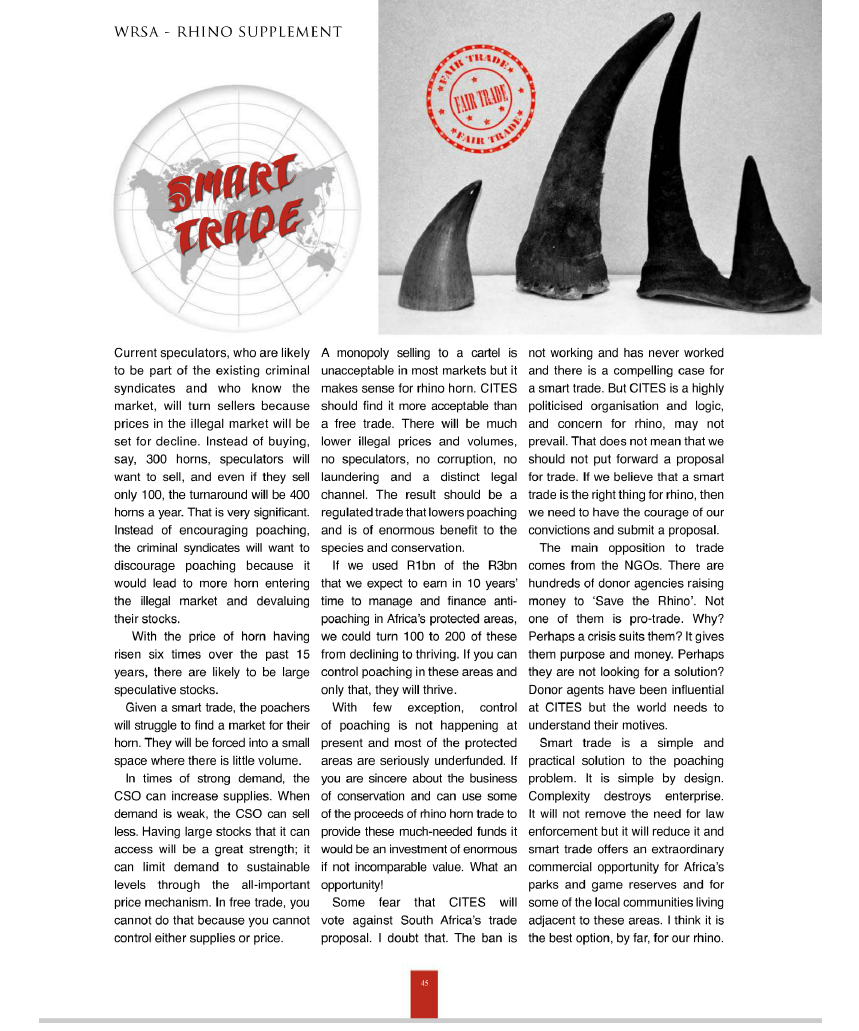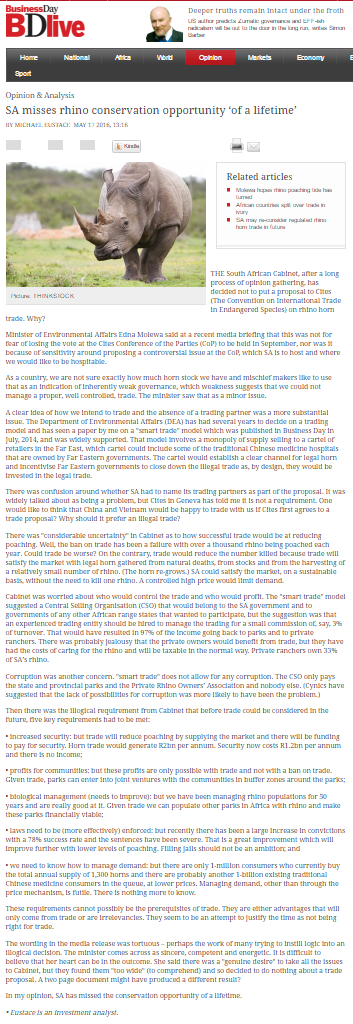
As many of you know, I have long asked the people who believe in legalising the international trade in rhino horn to produce their business case and user analysis. The reason I have asked these questions is that since I started interviewing the primary users of rhino horn, driving the current rhino killing spree, it became apparent straight away that they don’t see horn from a farmed rhino as a substitute product.
I wrote about this in: https://natureneedsmore.org/farmed-rhino-horn-not-seen-as-substitute-product/ As I say in the blog: When I was in South Africa earlier this year (Feb 2015) all my meetings clearly showed that very few people understood the nature of the demand or the users of genuine rhino horn. This is obviously very concerning since the South African government appears to be actively pursuing a trade legalisation agenda and they are creating risk-benefit models for pro/anti trade decisions based on incomplete information.
Yes, I heard that southern white rhinos are easy to farm “They are just like cows” one person said, “easy to manage, like dogs” said another. Significantly, not enough people are asking the right questions: “Whilst we know that horns can be harvested for sale, are these the rhino horns that the wealthy users, driving the poaching of wild rhinos, will want to buy? Are farmed horns a substitute product for horns from wild rhinos to the primary user groups?” BTB’s research has always indicated a farmed product is not seen as a substitute product by the wealthy Vietnamese elite who can afford to buy genuine, wild rhino horn. They are interested in the wild ‘product’ and so while the demand remains the poaching will continue.
When this blog was posted on some of the pro-trade social media groups the pro-trade response was as expected, ‘lobbying 101 techniques’ of deflection and counter-attack, but not answering very basic business case questions: https://natureneedsmore.org/pro-trade-response-to-blog/ My statement at the end of the blog “Obviously the lack of any useful response means that there is neither the willingness nor the ability on the pro-trade side to engage with the real aspects of the debate. Similarly, if the response is silence this is also be very telling!” may have triggered an email I received from some in the pro-trade community, pointing me to two pieces of information “I would like to recommend the following links”. http://za.zinio.com/reader.jsp?issue=416351493&o=ext “And please watch this video”: https://vimeo.com/135540882 and asking me “We are striving to make a rhino worth more alive than dead. Will you join us in this cause?”
I have commented on the vimeo video in a previous blog, pointing to the fact that, in the one hour it runs, the only time there is a suggestion about the specifics of the demand, one of their go-to economists, Michael ‘t Sas-Rolfes states ‘What they [rhino horns] are used for is hardly relevant. The fact is that people are willing to pay.’
With this blog, I will comment on one of the articles published in the special ‘Rhino Horn Trade’ edition of Wildlife Ranching, a publication for the wildlife ranching industry of South Africa. The article is by Michael Eustace. For those who can’t access the link I show each page below before I comment.

First massive assumption: demand is in the region of 1,500/year: The level of demand cannot be deduced from how many horns have been poached (sold). This is a supply-restricted market, the level of supply is not an indication of actual demand. The reason 90%+ of what is sold in Viet Nam is fake rhino horn is because demand is much higher than supply.
Assumption: Free trade is not fundamental, it is an ideological choice favoured by those standing to gain from the sale – private rhino owners. The whole argument about what form legal trade should take is a red herring – it presumes that legalising trade is the right thing to do.

Comment: As stated in the article: http://www.bdlive.co.za/national/science/2014/06/13/high-level-report-calls-sa-wildlife-trade-policy-reckless “the relatively small number of legal suppliers would have a powerful incentive to retain a monopoly and not lower costs.” This Smart Trade/cartel approach outlined confirms that suppliers want to restrict supply to keep prices high, so in reality it is all about making money, not conservation of the rhino.
Assumption: They want to keep the prices high, to maintain profits for sellers. But they are making the assumption that poachers won’t take advantage of this controlled, high price to launder illegal rhino horn in to the legal market??? Assuming legalising markets would then reduce or even eliminate profitability for poachers while maintaining high returns for legal suppliers makes NO sense.
Assumption: Statement that “There will be no room for corruption” is ridiculous. Corruption exists in South Africa and according to Transparency International corruption is a growing problem in the country. So claiming that there will be no corruption, no trade in illegally obtained horn and that 97% of proceeds will go into conservation are very big assumptions.
Assumption: Given that current demand is way higher than supply, there is no way of claiming that poaching will fall to ‘200 horns’ pa, as the article states.

Assumption: TCM is not the major consumer of rhino horn and it is not China. If you are this clueless about the actual demand, perhaps you shouldn’t be writing about how to create a legalised market!
Assumption: That most horn sold in Viet Nam is fake has absolutely no relation to whether or not genuine horn is sold. Claiming Viet Nam represents 10% of genuine horn market is based on a flawed assumption or is deliberately misleading.
Comment: The claim that Viet Nam represents 10% of genuine horn based appears to be based on quotes from John Hank’s (radio interview) https://soundcloud.com/search?q=trang%20rhinos and contradicts the research of Tom Milliken and Jo Shaw: http://www.npr.org/documents/2013/may/traffic_species_mammals.pdf What is interesting is that I have never seen anything where the current WWF/TRAFFIC team (Milliken and Shaw) have challenged old WWF (Hanks) statement that Viet Nam represents 10% of the demand. If they have, I haven’t seen it.
Assumption: There is no evidence that creating parallel legal markets makes illegal products cheaper. Knowing the users of rhino horn and their reasons for consuming illegal horn it will trade at a premium, not a discount.

Assumption: The CSO/cartel can only increase supplies in response to strong demand if such supplies are available. There is a reason this whole article is built around 1,500 or 2,000 horns a year – that’s what’s available. What if demand is 10,000 horns a year? Or 30,000? (Remember: Vietnam’s population: 90Million, China 1.4 Billion compared to Yemen at last rhino war of 1980s which was around 7Million)
Assumption: Stating that the ban didn’t work is wrong, it worked for 17 years up to 2007, just check the SA statistics.
Comment: Questioning the motivations of the NGOs is interesting. The content of this article clearly shows that what motivates the private owners pushing for trade is profits.
Assumption: There is nothing simple about a legalised trade. Neither South Africa nor Viet Nam have the underlying institutions to control supply and demand, corruption, laundering etc.

In addition, Eustace wrote another article recently where he states the same old arguments. He made an additional statement in it that is very self-serving from the pro-trade point of view (from the article):
Laws need to be (more effectively) enforced: but recently there has been a large increase in convictions with a 78% success rate and the sentences have been severe. That is a great improvement which will improve further with lower levels of poaching.
He fails to acknowledge that ‘The Devil is in the Detail‘ and that in effect the conviction rates are more like 15%.
We need to remember that it is the best interest of pro-trade groups if:
- The South African Government is seen to be making inroads in to the arrests and prosecutions of the poachers, while at the same time
- Rhino poaching numbers remain high
We have had 3 years of this pro-trade/no-trade debate and the media haven’t moved much beyond “Can a trade in rhino horn save the rhino?” There is plenty of evidence that it won’t work.
Both articles by Michael Eustace highlight the foolish assumptions that the pro-trade community is using as a way to justify their push for a legalised trade (and making lots of money, not that they talk about that, mind you).
What’s keeping this whole argument in business is the lack of a coordinated anti-trade response from conservation bodies and governments.
If all the main players in rhino conservation and all the key governments with a vote at CITES would categorically state that they will oppose a legalised trade, at any point in time, then we could finally move on from these self-serving arguments of those who stand to gain immense riches from trading in horn.
These are the views of the author: Dr. Lynn Johnson, Founder, Breaking the Brand
